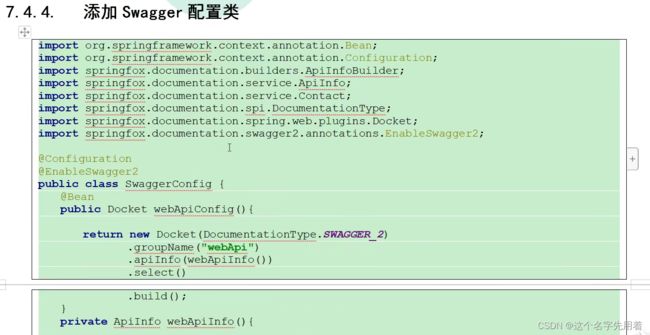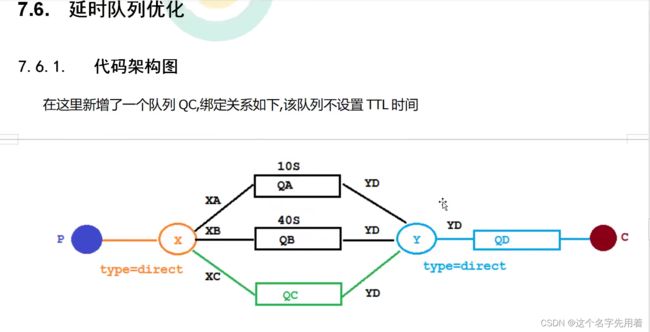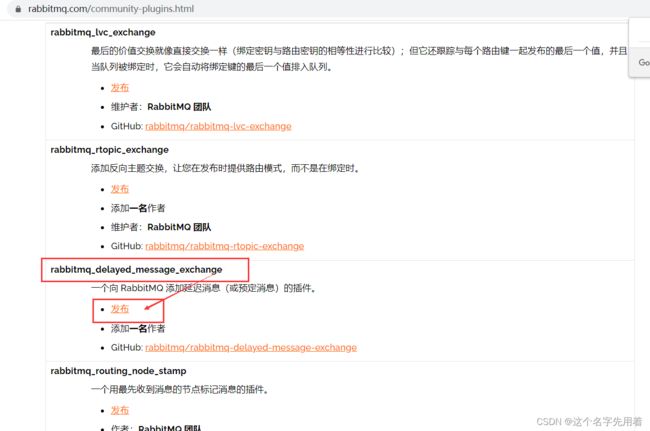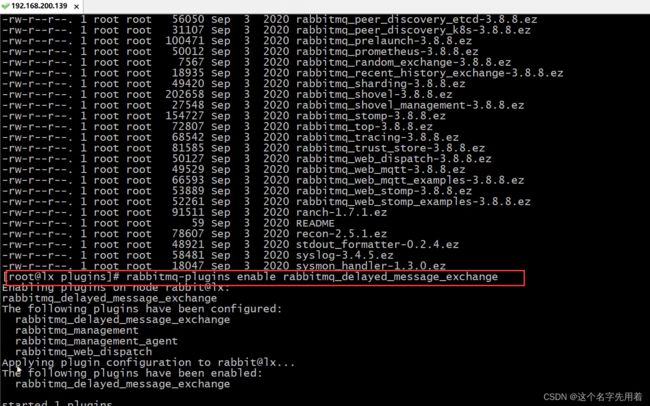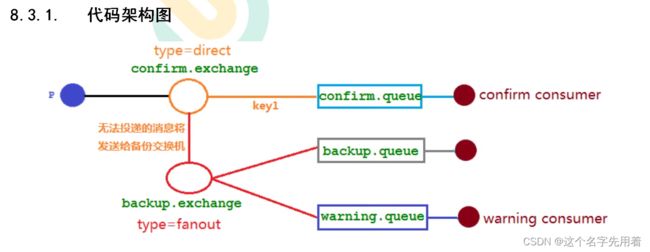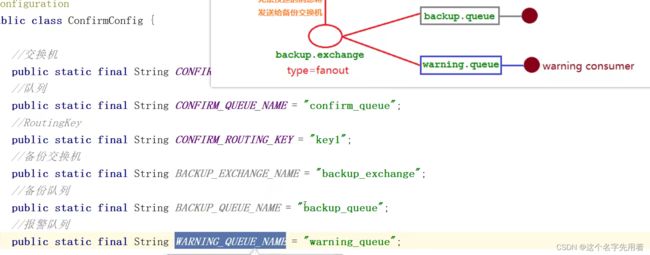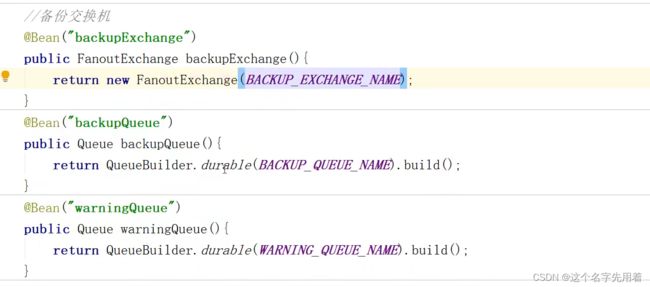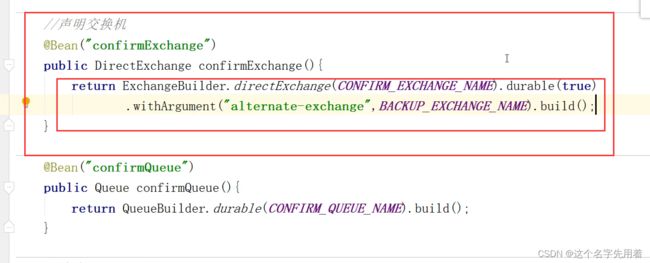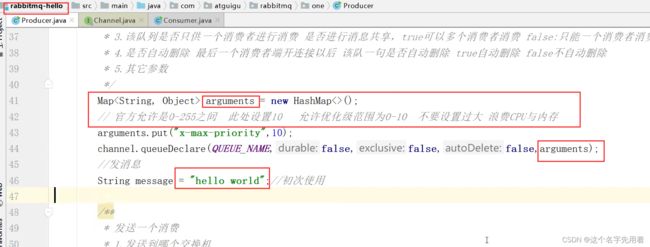springboot整合RabbitMQ
目录
-
-
- springboot整合RabbitMQ的依赖和yml:
- 死信队列TTL(存活时间):
- 延迟队列的优化:(设置灵活的到期时间)
- RabbitMQ延迟插件实现延迟队列:
- 发布确认高级:
-
- 发布确认的springboot版本:
- 交换机回调接口:
- 回退消息接口:
- 备份交换机:
- 其他知识:
-
springboot整合RabbitMQ的依赖和yml:
依赖:
org.springframework.boot
spring-boot-starter
org.springframework.boot
spring-boot-starter-amqp
2.2.2.RELEASE
org.springframework.amqp
spring-rabbit-test
2.3.9
test
org.springframework.boot
spring-boot-starter-web
2.5.0
org.springframework.boot
spring-boot-devtools
runtime
true
com.alibaba
fastjson
1.2.73
org.projectlombok
lombok
true
org.springframework.boot
spring-boot-starter-test
test
yml配置:
application.yml:
server:
port: 8080
spring:
#rabbitmq的配置
rabbitmq:
host: 192.168.211.200
port: 5672
username: admin
password: 123
死信队列TTL(存活时间):
package com.example.springbootrabbitmq.config;
import org.springframework.context.annotation.Configuration;
import org.springframework.amqp.core.*;
import org.springframework.beans.factory.annotation.Qualifier;
import org.springframework.context.annotation.Bean;
import java.util.HashMap;
@Configuration
public class TtlQueueConfig {
//普通交换机的名称
public static final String X_EXCHANGE = "X";
//死信交换机的名字
public static final String Y_DEAD_LETTER_EXCHANGE = "Y";
//普通队列的名称
public static final String QUEUE_A = "QA";
public static final String QUEUE_B = "QB";
//死信队列的名称
public static final String DEAD_LETTER_QUEUE = "QD";
//mq组件的声明
//声明xEchange 别名
@Bean("xExchange")
public DirectExchange xExchange(){
return new DirectExchange(X_EXCHANGE);//创建一个直接类型的交换机,名字为X
}
@Bean("yExchange")//声明yExchange别名
public DirectExchange yExchange(){
//创建一个直接类型的死信交换机,名字为Y
return new DirectExchange(Y_DEAD_LETTER_EXCHANGE);
}
//声明三个队列,两个普通,一个死信
//声明普通队列QA的TTL为10s,设置QA队列
@Bean("queueA")
public Queue queueA(){
HashMap arguments = new HashMap<>(3);
//设置死信交换机,即队列QA需要连接到死信交换机Y,
arguments.put("x-dead-letter-exchange",Y_DEAD_LETTER_EXCHANGE);
//设置死信交换机的漏由key,即队列QA需要连接到死信交换机Y的口令
arguments.put("x-dead-letter-routing-key","YD");
//设置TTL过期时间 ,单位是ms,即在队列 QA中存活多久后进入死信交换机
arguments.put("x-message-ttl",10000);
//队列的构建者实例化durable一个名字是QA的队列
return QueueBuilder.durable(QUEUE_A).withArguments(arguments).build();
}
//声明普通队列QB的TTL为40s,设置QB队列
@Bean("queueB")
public Queue queueB(){
HashMap arguments = new HashMap<>(3);
//设置死信交换机,即队列QB需要连接到死信交换机Y,
arguments.put("x-dead-letter-exchange",Y_DEAD_LETTER_EXCHANGE);
//设置死信交换机的漏由key,即队列QB需要连接到死信交换机Y的口令
arguments.put("x-dead-letter-routing-key","YD");
//设置TTL过期时间 ,单位是ms,即在队列 QB中存活多久后进入死信交换机
arguments.put("x-message-ttl",40000);
//队列的构建者实例化durable一个名字是QB的队列
return QueueBuilder.durable(QUEUE_B).withArguments(arguments).build();
}
//死信队列
@Bean()
public Queue queueD(){
//注意:我们的漏由和队列都关心自己本身和下游连接,这里队列QD下游没有参数,只是简单的消费者
return QueueBuilder.durable(DEAD_LETTER_QUEUE).build();
}
//绑定工作,即队列绑定到上游的漏由器。看图我们看到三个绑定
@Bean
public Binding queueABindingX(@Qualifier("queueA")Queue queueA,
@Qualifier("xExchange") DirectExchange xExchange){
//绑定器建造者绑定队列到交换机,用漏由key:XA
return BindingBuilder.bind(queueA).to(xExchange).with("XA");
}
@Bean
public Binding queueBBindingX(@Qualifier("queueB")Queue queueB,
@Qualifier("xExchange")DirectExchange xExchange){
return BindingBuilder.bind(queueB).to(xExchange).with("XB");
}
@Bean
public Binding queueDBindingY(@Qualifier("queueD")Queue queueD,
@Qualifier("yExchange")DirectExchange yExchange){
return BindingBuilder.bind(queueD).to(yExchange).with("YD");
}
}
消息生产者:
controller.SendMsgController:
package com.example.springbootrabbitmq.controller;
import lombok.extern.slf4j.Slf4j;
import org.springframework.amqp.rabbit.core.RabbitTemplate;
import org.springframework.beans.factory.annotation.Autowired;
import org.springframework.web.bind.annotation.GetMapping;
import org.springframework.web.bind.annotation.PathVariable;
import org.springframework.web.bind.annotation.RequestMapping;
import org.springframework.web.bind.annotation.RestController;
import java.util.Date;
@RestController
@Slf4j
@RequestMapping(value = "/ttl")
public class SendMsgController {
@Autowired
private RabbitTemplate rabbitTemplate;
@GetMapping("/sendMsg/{message}")
public void sendMsg(@PathVariable("message")String message){
log.info("当前时间:{},发送一条信息给两个ttl队列:{}",new Date().toString(),message);
//转变和发送 消息
rabbitTemplate.convertAndSend("X","XA","消息来自ttl为10s的队列:"+message);
rabbitTemplate.convertAndSend("X","XB","消息来自ttl为40s的队列:"+message);
}
}
消息消费者:
consumer.DeadLetterQueueConsumer:
package com.example.springbootrabbitmq.consumer;
import com.rabbitmq.client.Channel;
import lombok.extern.slf4j.Slf4j;
import org.springframework.amqp.core.Message;
import org.springframework.amqp.rabbit.annotation.RabbitListener;
import org.springframework.stereotype.Component;
import java.util.Date;
@Component
@Slf4j
public class DeadLetterQueueConsumer {
//接收消息
@RabbitListener(queues = "QD")
public void receiveD(Message message, Channel channel)throws Exception{
String msg = new String(message.getBody());
log.info("当前时间:{},收到死信队列的消息:{}",new Date().toString(),msg);
}
}
网页测试:http://localhost:8080/ttl/sendMsg/呵呵

延迟队列的优化:(设置灵活的到期时间)
配置类增加代码:
//增加一个队列QC,ttl时间是灵活的
@Bean("queueC")
public Queue queueC(){
HashMap arguments = new HashMap<>();
//设置死信交换机
arguments.put("x-dead-letter-exchange",Y_DEAD_LETTER_EXCHANGE);
//设置通往死信交换机的漏由key
arguments.put("x-dead-letter-routing-key","YD");
return QueueBuilder.durable(QUEUE_C).withArguments(arguments).build();
}
//绑定QC队列到x交换机,绑定需要参数
@Bean
public Binding queueCBindingX(@Qualifier("queueC")Queue queueC,
@Qualifier("xExchange")DirectExchange xExchange ){
return BindingBuilder.bind(queueC).to(xExchange).with("XC");
}
Expiration:到期
controller中增加的代码:
@GetMapping("/sendExpirationMsg/{message}/{ttlTime}")
public void sendMsg(@PathVariable("message")String message,
@PathVariable("ttlTime")String ttlTime){
log.info("当前时间:{},发送一条时长{}毫秒ttl信息给队列QC:{}",
new Date().toString(),ttlTime,message);
rabbitTemplate.convertAndSend("X","XC",message,msg->{
//发送消息的时候 延迟时长;Expiration:到期
msg.getMessageProperties().setExpiration(ttlTime);
return msg;
});
}
测试:
http://localhost:8080/ttl/sendExpirationMsg/你好1/20000
http://localhost:8080/ttl/sendExpirationMsg/你好2/2000
RabbitMQ延迟插件实现延迟队列:
插件下载:
下载地址: https://www.rabbitmq.com/community-plugins.html
下载插件:rabbitmq_delayed_message_exchange-3.8.17.8f537ac.ez
rabbitmq_delayed_message_exchange-3.8.17.8f537ac.ez延时插件环境:
此版本针对RabbitMQ 3.8.16及以上版本。
此版本需要Erlang 23.2或更高版本,并支持Erlang 24。
#我的环境:
我这里使用centos8系统的
我的rabbitmq版本:3.8.26
我的Erlang版本:24.1.7
手动上传到自己rabbitmq的安装目录的插件目录下:
我的目录:
/usr/lib/rabbitmq/lib/rabbitmq_server-3.8.26/plugins
然后在插件目录下执行命令:rabbitmq-plugins enable rabbitmq_delayed_message_exchange

原理图:



配置类:
config.DelayedQueueConfig:
package com.example.springbootrabbitmq.config;
import org.springframework.amqp.core.Binding;
import org.springframework.amqp.core.BindingBuilder;
import org.springframework.amqp.core.CustomExchange;
import org.springframework.amqp.core.Queue;
import org.springframework.beans.factory.annotation.Qualifier;
import org.springframework.context.annotation.Bean;
import org.springframework.context.annotation.Configuration;
import java.util.HashMap;
@Configuration
public class DelayedQueueConfig {
//队列
public static final String DELAYED_QUEUE_NAME = "delayed.queue";
//交换机
public static final String DELAYED_EXCHANGE_NAME = "delayed.exchange";
//routing-key
public static final String DELAYED_ROUTING_KEY = "delayed.routingkey";
@Bean //自定义的交换机CustomExchange
public CustomExchange delayedExchange(){
HashMap arguments = new HashMap<>();
arguments.put("x-delayed-type","direct");
return new CustomExchange(DELAYED_EXCHANGE_NAME,"x-delayed-message",
true,false,arguments);
}
@Bean //延迟队列
public Queue delayedQueue(){
return new Queue(DELAYED_QUEUE_NAME);
}
//绑定
@Bean
public Binding delayedQueueBindingDelayedExchange(
@Qualifier("delayedQueue")Queue delayedQueue,
@Qualifier("delayedExchange")CustomExchange delayedExchange
){
return BindingBuilder.bind(delayedQueue).to(delayedExchange)
.with(DELAYED_ROUTING_KEY).noargs();
}
}
custom:风俗,习惯,自定义,顾客
参数:arguments或者parameter
controller发送消息:增加的代码如下:
//开始发送消息:基于插件的消息 及延迟的时间
@GetMapping("/sendDelayMsg/{message}/{delayTime}")
public void sendMsg(@PathVariable("message")String message,
@PathVariable("delayTime")Integer delayTime){
log.info("当前时间:{},发送一条时长{}毫秒信息给延迟队列delay.queue:{}",
new Date().toString(),delayTime,message);
rabbitTemplate.convertAndSend(DelayedQueueConfig.DELAYED_EXCHANGE_NAME
, DelayedQueueConfig.DELAYED_ROUTING_KEY,message,(msg)->{
//发送消息的时候 延迟时长 ,单位ms
msg.getMessageProperties().setDelay(delayTime);
return msg;
});
}
消费者:consumer.DelayQueueConsumer:
package com.example.springbootrabbitmq.consumer;
import com.example.springbootrabbitmq.config.DelayedQueueConfig;
import lombok.extern.slf4j.Slf4j;
import org.springframework.amqp.core.Message;
import org.springframework.amqp.rabbit.annotation.RabbitListener;
import org.springframework.stereotype.Component;
import java.util.Date;
//消费者,基于插件的延迟消息
@Slf4j
@Component
public class DelayQueueConsumer {
//监听消息
@RabbitListener(queues = DelayedQueueConfig.DELAYED_QUEUE_NAME)
public void receiveDelayQueue(Message message){
String msg = new String(message.getBody());
log.info("当前时间:{},收到延迟队列的消息:{}",new Date().toString(),msg);
}
}
测试:
http://localhost:8080/ttl/sendDelayMsg/come on baby1/20000
http://localhost:8080/ttl/sendDelayMsg/come on baby2/2000

发布确认高级:
发布确认的springboot版本:
修改yml配置文件:
yml增加配置:spring.rabbitmq.publisher-confirm-type=correlated #关联的,相关的

单词说明:
correlated #关联的,相关的
broker :代理商,中间件
添加配置类:
config.ConfirmConfig:
package com.example.springbootrabbitmq.config;
import org.springframework.amqp.core.*;
import org.springframework.beans.factory.annotation.Qualifier;
import org.springframework.context.annotation.Bean;
import org.springframework.context.annotation.Configuration;
@Configuration
public class ConfirmConfig {
//声明交换机,队列,routingkey 的名字
public static final String CONFIRM_EXCHANGE_NAME = "confirm.exchange";
public static final String CONFIRM_QUEUE_NAME = "confirm.queue";
public static final String CONFIRM_ROUTING_KEY = "key1";
//声明创建交换机
@Bean("confirmExchange")
public DirectExchange confirmExchange(){
return new DirectExchange(CONFIRM_EXCHANGE_NAME);
}
//声明创建队列
@Bean("confirmQueue")
public Queue confirmQueue(){
return QueueBuilder.durable(CONFIRM_QUEUE_NAME).build();
}
//绑定队列到其上游的交换机
@Bean
public Binding queueBindingExchange(@Qualifier("confirmQueue")Queue confirmQueue,
@Qualifier("confirmExchange")DirectExchange confirmExchange){
return BindingBuilder.bind(confirmQueue).to(confirmExchange).with(CONFIRM_ROUTING_KEY);
}
}
controller发消息:
ProducerController:
package com.example.springbootrabbitmq.controller;
import com.example.springbootrabbitmq.config.ConfirmConfig;
import lombok.extern.slf4j.Slf4j;
import org.springframework.amqp.rabbit.core.RabbitTemplate;
import org.springframework.beans.factory.annotation.Autowired;
import org.springframework.boot.autoconfigure.AutoConfigureOrder;
import org.springframework.web.bind.annotation.GetMapping;
import org.springframework.web.bind.annotation.PathVariable;
import org.springframework.web.bind.annotation.RequestMapping;
import org.springframework.web.bind.annotation.RestController;
@RestController
@Slf4j
@RequestMapping("/confirm")
public class ProducerController {
@Autowired
private RabbitTemplate rabbitTemplate;
//发消息
@GetMapping("/sendMessage/{message}")
public void sendMessage(@PathVariable("message")String message){
//发消息:-->先找到要发给的交换-->然后是此交换机的下级漏由key-->然后具体的消息是什么
rabbitTemplate.convertAndSend(ConfirmConfig.CONFIRM_EXCHANGE_NAME,
ConfirmConfig.CONFIRM_ROUTING_KEY,message);
log.info("发送的消息内容是:{}",message);
}
}
消息的消费方:
consumer.ConfirmConsumer:
package com.example.springbootrabbitmq.consumer;
import com.example.springbootrabbitmq.config.ConfirmConfig;
import lombok.extern.slf4j.Slf4j;
import org.springframework.amqp.core.Message;
import org.springframework.amqp.rabbit.annotation.RabbitListener;
import org.springframework.stereotype.Component;
@Component
@Slf4j
public class ConfirmConsumer {
//监听队列中的消息,指定队列名字
@RabbitListener(queues = ConfirmConfig.CONFIRM_QUEUE_NAME)
public void receiveConfirmMessage(Message message){
String msg = new String(message.getBody());
log.info("接收到的队列confirm.queue消息:{}",msg);
}
}
测试:http://localhost:8080/confirm/sendMessage/呵呵哒
测试通过:

交换机回调接口:
改良:设置交换机回调接口:
config.MyCallBack:
package com.example.springbootrabbitmq.config;
import lombok.extern.slf4j.Slf4j;
import org.springframework.amqp.rabbit.connection.CorrelationData;
import org.springframework.amqp.rabbit.core.RabbitTemplate;
import org.springframework.beans.factory.annotation.Autowired;
import org.springframework.stereotype.Component;
import javax.annotation.PostConstruct;
@Component
@Slf4j //点进去RabbitTemplate这个类,下载源码,ConfirmCallback是确认回调接口
public class MyCallBack implements RabbitTemplate.ConfirmCallback {
@Autowired
private RabbitTemplate rabbitTemplate;
// PostConstruct 注释用于在依赖关系注入完成之后需要执行的方法上,以执行任何初始化。
/*应用 PostConstruct 注释的方法必须遵守以下所有标准:该方法不得有任何参数,除非是在
EJB 拦截器 (interceptor) 的情况下,根据 EJB 规范的定义,在这种情况下它将带有一个
InvocationContext 对象 ;该方法的返回类型必须为 void;该方法不得抛出已检查异常;
应用 PostConstruct 的方法可以是 public、protected、package private 或 private;
除了应用程序客户端之外,该方法不能是 static;该方法可以是 final;如果该方法抛出未检查异常,
那么不得将类放入服务中,除非是能够处理异常并可从中恢复的 EJB。
*/
@PostConstruct // PostConstruct 注释用于在依赖关系注入完成之后需要执行的方法上,以执行任何初始化。
public void init(){
//setConfirmCallback(ConfirmCallback confirmCallback)
rabbitTemplate.setConfirmCallback(this); //this代表此类MyCallBack
}
/*
交换机不管是否收到消息的一个回调方法
correlationData:消息相关的数据
ack:交换机是否收到消息
cause:交换机没有收到消息的原因
*/
@Override
public void confirm(CorrelationData correlationData, boolean ack, String cause) {
String id = correlationData != null ? correlationData.getId() : "" ;
if(ack){
log.info("交换机ok,收到id为{}的消息",id);
}else{
log.info("交换机error,没有收到id为{}的消息,原因是:{}",id,cause);
}
}
}
correlation data:相关数据/关联数据
消息生产者:
controller.ProducerController:
package com.example.springbootrabbitmq.controller;
import com.example.springbootrabbitmq.config.ConfirmConfig;
import lombok.extern.slf4j.Slf4j;
import org.springframework.amqp.rabbit.connection.CorrelationData;
import org.springframework.amqp.rabbit.core.RabbitTemplate;
import org.springframework.beans.factory.annotation.Autowired;
import org.springframework.web.bind.annotation.GetMapping;
import org.springframework.web.bind.annotation.PathVariable;
import org.springframework.web.bind.annotation.RequestMapping;
import org.springframework.web.bind.annotation.RestController;
@RestController
@Slf4j
@RequestMapping("/confirm")
public class ProducerController {
@Autowired
private RabbitTemplate rabbitTemplate;
//发消息
@GetMapping("/sendMessage/{message}")
public void sendMessage(@PathVariable("message")String message){
//创建correlationData相关数据
CorrelationData correlationData = new CorrelationData("1");
//发消息:-->先找到要发给的交换-->然后是此交换机的下级漏由key-->然后具体的消息是什么
rabbitTemplate.convertAndSend(ConfirmConfig.CONFIRM_EXCHANGE_NAME+"123",
ConfirmConfig.CONFIRM_ROUTING_KEY,message,correlationData);
log.info("发送的消息内容是:{}",message);
}
}
测试错的队列:
//发消息
@GetMapping("/sendMessage/{message}")
public void sendMessage(@PathVariable("message")String message){
//----------------1.测试交换机出错的情况-------------
//创建correlationData相关数据
CorrelationData correlationData = new CorrelationData("1");
//发消息:-->先找到要发给的交换-->然后是此交换机的下级漏由key-->然后具体的消息是什么
rabbitTemplate.convertAndSend(ConfirmConfig.CONFIRM_EXCHANGE_NAME,
ConfirmConfig.CONFIRM_ROUTING_KEY,message,correlationData);
log.info("发送的消息内容是:{}",message);
log.info("------------2.测试队列出错的情况---------------------");
//创建correlationData相关数据
CorrelationData correlationData2 = new CorrelationData("22");
//发消息:-->先找到要发给的交换-->然后是此交换机的下级漏由key-->然后具体的消息是什么
rabbitTemplate.convertAndSend(ConfirmConfig.CONFIRM_EXCHANGE_NAME,
ConfirmConfig.CONFIRM_ROUTING_KEY+"22",message+"key22",correlationData2);
log.info("发送的消息内容是:{}",message+"key22");
}
回退消息接口:
mandatory:强制
注意:这里需要下载源代码后重写方法:参数才能正确显示名称:
config.MyCallBack:
package com.example.springbootrabbitmq.config;
import lombok.extern.slf4j.Slf4j;
import org.springframework.amqp.core.ReturnedMessage;
import org.springframework.amqp.rabbit.connection.CorrelationData;
import org.springframework.amqp.rabbit.core.RabbitTemplate;
import org.springframework.beans.factory.annotation.Autowired;
import org.springframework.stereotype.Component;
import javax.annotation.PostConstruct;
@Component
@Slf4j //点进去RabbitTemplate这个类,下载源码,ConfirmCallback是确认回调接口
public class MyCallBack implements RabbitTemplate.ConfirmCallback,RabbitTemplate.ReturnsCallback {
@Autowired
private RabbitTemplate rabbitTemplate;
// PostConstruct 注释用于在依赖关系注入完成之后需要执行的方法上,以执行任何初始化。
/*应用 PostConstruct 注释的方法必须遵守以下所有标准:该方法不得有任何参数,除非是在
EJB 拦截器 (interceptor) 的情况下,根据 EJB 规范的定义,在这种情况下它将带有一个
InvocationContext 对象 ;该方法的返回类型必须为 void;该方法不得抛出已检查异常;
应用 PostConstruct 的方法可以是 public、protected、package private 或 private;
除了应用程序客户端之外,该方法不能是 static;该方法可以是 final;如果该方法抛出未检查异常,
那么不得将类放入服务中,除非是能够处理异常并可从中恢复的 EJB。
*/
@PostConstruct // PostConstruct 注释用于在依赖关系注入完成之后需要执行的方法上,以执行任何初始化。
public void init(){
//setConfirmCallback(ConfirmCallback confirmCallback),this代表此类MyCallBack
rabbitTemplate.setConfirmCallback(this);
//setReturnsCallback(RabbitTemplate.ReturnsCallback returnCallback),this代表此类MyCallBack
rabbitTemplate.setReturnsCallback(this);
}
/*
交换机不管是否收到消息的一个回调方法
correlationData:消息相关的数据
ack:交换机是否收到消息
cause:交换机没有收到消息的原因
*/
@Override
public void confirm(CorrelationData correlationData, boolean ack, String cause) {
String id = correlationData != null ? correlationData.getId() : "" ;
if(ack){
log.info("交换机ok,收到id为{}的消息",id);
}else{
log.info("交换机error,没有收到id为{}的消息,原因是:{}",id,cause);
}
}
@Override //被退回消息的所有内容被包装到这里了ReturnedMessage
public void returnedMessage(ReturnedMessage returned) {
log.info("消息{},被交换机{}退回,,应答码(ReplyCode):{},退回的原因是:{},漏由key是{}",
returned.getMessage(),returned.getExchange(),
returned.getReplyCode(),returned.getReplyText(),returned.getRoutingKey()
);
}
}
运行测试结果:
备份交换机:
其他知识:
幂等性:
实战:

